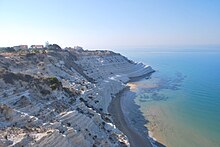Scala Dei Turchi
The Scala is formed by marl, a sedimentary rock with a characteristic white color, formed from the tests of planktonic foraminifera. They belong to the Trubi Formation, a marine sedimentary unit of Lower Pliocene (Zanclean) age, which were deposited after the Zanclean flood, in which the Mediterranean refilled after having previously nearly completely desiccated during the Messinian salinity crisis. The cliffs lie between two sandy beaches and are a limestone rock formation in the shape of a staircase, hence the name. The latter part of the name derives from the frequent piracy raids by the Saracens during the Middle Ages, and Barbary pirates, called Turks, because the Ottoman Empire (1299–1922) also encompassed North Africa; the Turkish pirates, in fact, found shelter in this area less beaten by the winds and represented a safer landing and boarding place.
In August 2007 the municipality of Realmonte applied for the inclusion of the Scala dei Turchi (together with the nearby Roman Villa Aurea) in the UNESCO Heritage List.
In February 2020, following years of complaints about the poor environmental protection of the site from erosion and vandalism by tourists, Italian prosecutors seized control of the site. They ordered its temporary closure for monitoring and announced that they were investigating a man who claimed ownership of the site in a dispute with the Realmonte local authority.
In January 2022, the site was stained red by vandals.


References
- ^ "Scala dei Turchi (AG)". www.geositidisicilia.it. Retrieved 2021-08-12.
- ^ Tondo, Lorenzo (28 February 2020). "Prosecutors seize Italian Scala dei Turchi over conservation concerns". The Guardian. Retrieved 28 February 2020.
- ^ "Scala dei Turchi: Sicily's famed cliffs streaked red by vandals". BBC News. 2022-01-09. Retrieved 2022-01-10.
37°17′24″N 13°28′22″E / 37.2900°N 13.4728°E